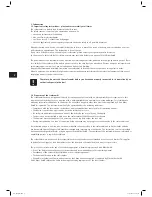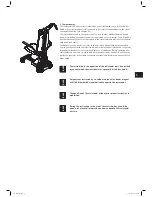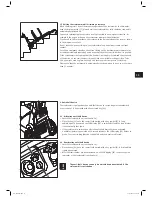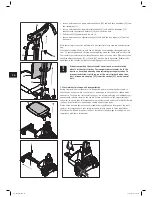
8
2.3 Sitting down on the seat
To secure the scalacombi against inadvertent movement during the transfer of a person
to the stair climber, move the drive wheels a little backwards away from the pushing
position (see diagram to the left) so that the housing is properly placed on the floor.
To do this, switch the scalacombi on (see chapter 2.4) and then press the driving switch
[17] to its lower position (see chapter 3.1). Then switch the scalacombi off (see chapter
2.5).
Before allowing a person to sit down on the scalacombi, ensure that the stair climber is
switched off!
The passenger normally sits down on the stair climber seat [20] from the front. If this
cannot be done easily or is not possible at all, you can remove the two armrests [21] to
transfer the person to the stair climber, using for example a seating aid.
To do this, pull the two armrests [21] upwards from their receptacles.
Allow the person to sit down on the scalacombi and position his/her feet properly on
the footrest [2].
Insert the armrests [21] in the receptacles [14] of the scalacombi.
Ensure that the armrests [21] properly engage in the receptacles [14] and cannot be
turned.
When the person to be transported is properly seated on the scalacombi, switch the
device on and begin climbing the stairs.
If you have moved the drive wheels as described above towards a back position to facili-
tate sitting down on the climber, you should move them back to their pushing position.
To do this, switch the scalacombi on (see chapter 2.4) and then move the driving switch
[17] to its upper position until the climber is automatically switched off. The wheels are
now in pushing position (see chapter 3.2).
If necessary, secure the feet and legs of the person on the scalacom-
bi using the foot belt (optional accessory) and tighten the lap belt
(optional accessory) around the person‘s waist.
Ensure that the feet of the passenger are at all times placed on the
footrest [2].
•
•
•
•
•
21
2
21
2
14
14
14
14
!!
!!
GA_S34_GB.indd 8
31.01.2011 09:47:47












































